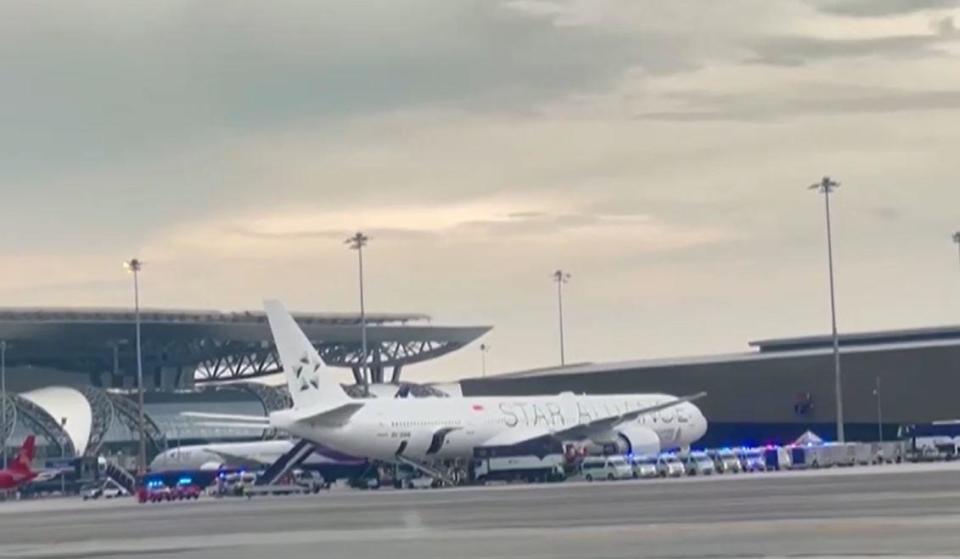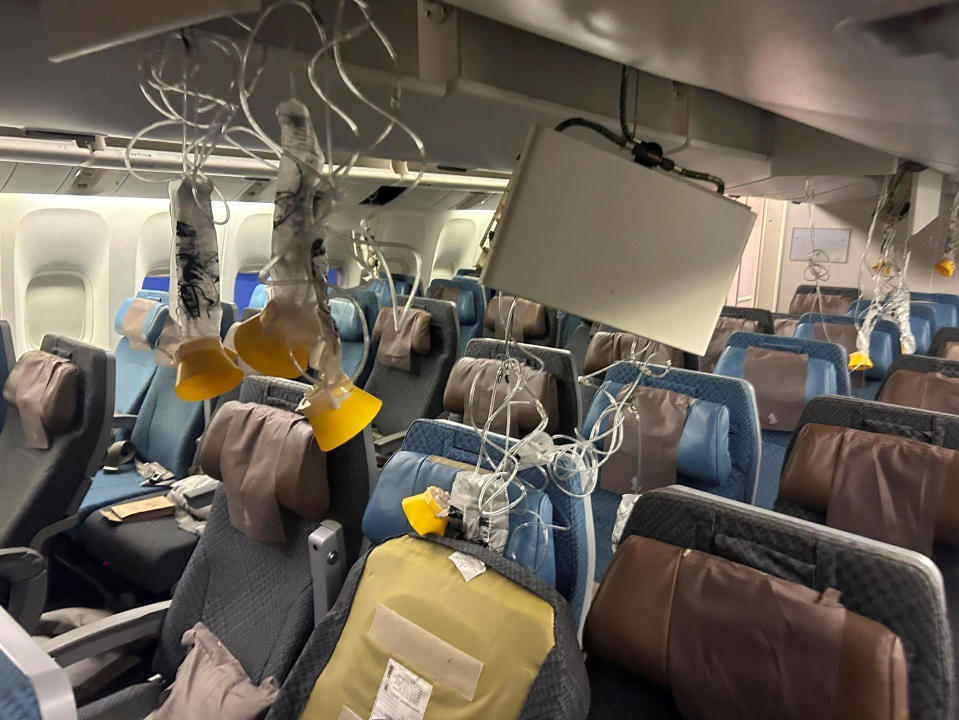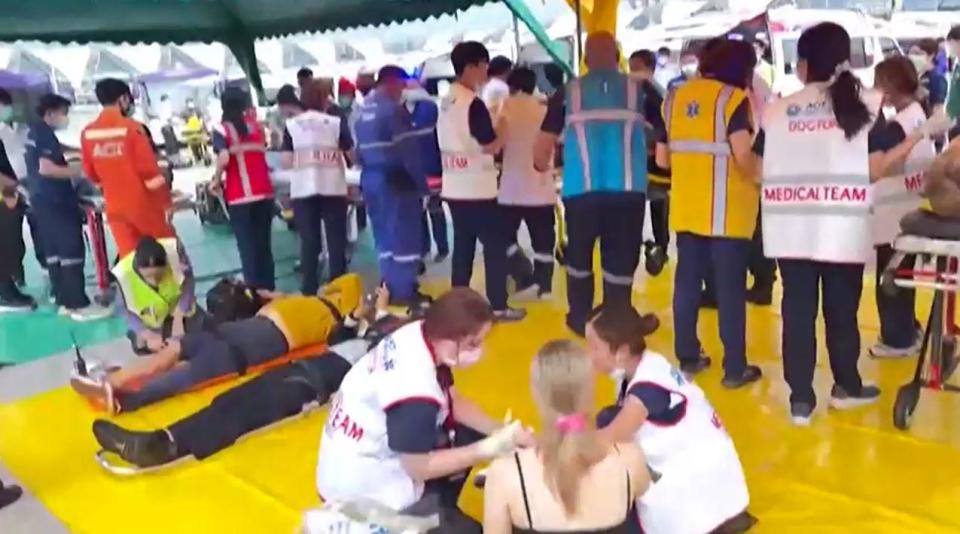1 dead as Singapore Airlines flight from London hits severe turbulence
One person on a Singapore Airlines flight died and dozens of others were injured when the plane traveling from London to Singapore "encountered sudden extreme turbulence," the airline said Tuesday. Flight SQ321 from London's Heathrow Airport was diverted to Bangkok and touched down at 3:45 p.m. local time Tuesday at Suvarnabhumi Airport, the carrier said in a statement posted to its Facebook page.
"We can confirm that there are injuries and one fatality on board the Boeing 777-300ER," an earlier statement said, adding that there were 211 passengers and 18 crew members on the plane.
The passenger who died was a 73-year-old British man, officials said. Seven people, including some with head injuries, were critically injured, and dozens of others were hurt with varying injuries, Suvarnabhumi Airport director Kittipong Kittikachorn said at a news conference.
Bangkok's Samitivej Srinakarin Hospital said it treated 71 people in total, including six with severe injuries, news agencies reported.

CBS News' partner network BBC News reported that the man who died was believed to have suffered a heart attack during the turbulence.
What causes turbulence and how to stay safe on a flight
Video from the Thai airport showed passengers coming down a ramp onto the tarmac from the plane, which was surrounded by emergency vehicles.
Several people could be seen laying on a tarp under a tent in a triage area crowded by airport and medical staff.
The airline offered "its deepest condolences to the family of the deceased" and said it was providing assistance to all passengers and crew from the flight.
Boeing also offered condolences to the family of the passenger who died in a statement posted on social media. The U.S. aerospace giant said it was in contact with Singapore Airlines and ready to support the carrier as it looked into the incident.

Tracking data from the FlightAware website showed the Singapore Airlines plane dropping suddenly from an altitude of about 37,000 feet to 31,000 feet in the space of only about five minutes. The drop came about 10 hours into the flight from London as the Boeing 777 finished crossing the Andaman Sea and approached the Thai coast. Thunderstorms were reported in the area.
"Suddenly the aircraft starts tilting up and there was shaking, so I started bracing for what was happening, and very suddenly there was a very dramatic drop, so everyone seated and not wearing seatbelt was launched immediately into the ceiling," passenger Dzafran Azmir told the Reuters news agency. "Some people hit their heads on the baggage cabins overhead and dented it. They hit the places where lights and masks are and broke straight through it."

Another passenger, Andrew Davies, who spoke with BBC News on Tuesday about the harrowing flight, posted a series of messages on social media earlier describing the incident.
"Awful experience," he said. "Lots of people injured — including the air stewards who were stoic and did everything they could."
Davies said there was "very little warning" before the plane plummeted, but that the seatbelt warning light had come on.
"I put on my seatbelt straightaway then the plane just dropped," he said, describing chaos in the cabin as people shouted for a defibrillator and passengers with medical training tried to assist those injured.
"One of the Singapore Airlines crew said it was by far the worst in her 30 years of flying," Davies said in one tweet, adding: "Lesson is — wear a seatbelt at ALL TIMES. Anyone who is injured, was not wearing a seatbelt."
Four Americans were on the flight, according to the airline. The rest of the passengers included 56 from Australia, 47 from the U.K., 41 from Singapore, 23 from New Zealand, 16 from Malaysia, five from the Philippines, four from Ireland, three from India, two each from Canada, Indonesia, Myanmar and Spain, and one each from Germany, Iceland, Israel and South Korea.
While in-flight turbulence is increasingly common on many routes, deaths and serious injuries are rare. Four people were injured by severe turbulence on a domestic U.S. flight in Florida in July 2023.
An investigation is underway into the Singapore Airlines incident.
"It's extremely rare to have a turbulence event result in fatalities," said CBS News aviation analyst and former NTSB chair Robert Sumwalt.
"What I would call this right now is an in-flight upset — whether that is a result of atmospheric turbulence or whether it's the result of something else," he said, adding, "Too early to know for sure at this point."
Although the causes in this incident are not yet clear, climatologists have warned travelers to brace for more flight delays and cancellations and more frequent and more severe turbulence, especially on routes over the world's fast-warming oceans, as a result of climate change.
CBS News climate producer Tracy Wholf says the impacts of climate change on air travel are far broader than just increasing turbulence, with airports being affected by exacerbated flooding, extreme heat and precipitation hindering takeoffs and landings and even a rise in midair lightning strikes.
–Kris Van Cleave and Alex Sundby contributed reporting.
The Dish: Spaghetti stir fry is a family favorite
Why Trump's defense only called 2 witnesses before resting case
Granddaughter of Georgia Tech's first Black graduate gets degree from same school

